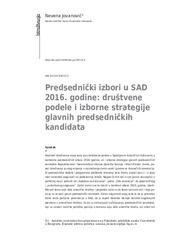Predsednički izbori u SAD 2016. godine: društvene podele i izborne strategije glavnih predsedničkih kandidata
Presidential elections in the USA 2016: Social divisions and campaign strategies of two presidential candidates
| dc.creator | Jovanović, Nevena | |
| dc.date.accessioned | 2024-03-06T12:44:48Z | |
| dc.date.available | 2024-03-06T12:44:48Z | |
| dc.date.issued | 2023 | |
| dc.identifier.issn | 2217-7000 | |
| dc.identifier.uri | http://rfpn.fpn.bg.ac.rs/handle/123456789/1189 | |
| dc.description.abstract | Predmet istraživanja ovog rada jesu društvene podele u Sjedinjenim Američkim Državama u kontekstu predsedničkih izbora 2016. godine, ali i izborne strategije glavnih predsedničkih kandidata Republikanske i Demokratske stranke Donalda Trampa i Hilari Klinton. Dakle, pored istraživanja javnog mnjenja u razmatranje ćemo uzeti i govore sa stranačkih konvencija, tri predsedničke debate i programske platforme stranaka kako bismo ispitali jesu li i u kojoj meri kandidati odgovorili na preferencije birača. Najpre će biti reči o socijalnim rascepima u političkoj nauci počevši od „hipoteze zamrzavanja”, preko „tihe revolucije” do populističkog i „autoritarnog odgovora”. Zatim ćemo sve to staviti u kontekst izbora 2016. godine, identifikovati teme koje dele američko društvo i pogledati kako su te teme komunicirali i koje pozicije su zauzeli glavni predsednički kandidati. Glavni argument ovog rada je da je primetan trend rasta partijske polarizacije u SAD, da je uspeh Donalda Trampa rezultat dugotrajnih promena u američkom društvu, te da su zahvaljujući sučeljavanju predsedničkih kandidata, koji su zauzeli različite političke pozicije o temama koje dele američke birače, ovi izbori bili indikativan primer populističkog i autoritarnog odgovora na društveno-političke promene i smenu generacija, kao i dobra studija slučaja za uvid u rascepe u američkom društvu. | sr |
| dc.description.abstract | This paper aims to research social divisions in the United States of America in the context of the 2016 presidential elections, as well as the campaign strategies of the main presidential candidates of the Republican and Democratic parties, Donald Trump and Hillary Clinton. Therefore, in addition to public opinion research, we will also consider speeches from party conventions, three presidential debates and party program platforms in order to examine whether and to what extent the candidates responded to voters preferences. First, we will talk about social cleavages in political science, starting with the “freezing hypothesis”, through “silent revolution” to authoritarian populism and “cultural backlash”. We will then put all of this in the context of the 2016 US elections, to identify issues that divide American society and look at how these issues were communicated and what positions the presidential candidates took. The main conclusion is that there is a noticeable trend of growing party polarization in the USA, that Donald Trump’s success is the result of long-term changes in American society, and that thanks to the confrontation of presidential candidates, who took different political positions on issues that divide American voters, these elections were an indicative example of a populist and authoritarian response to socio-political changes and generational changes, as well as a good case study for insight into the cleavages in American society. | sr |
| dc.language.iso | sr | sr |
| dc.publisher | Beograd : Fakultet političkih nauka | sr |
| dc.rights | openAccess | sr |
| dc.rights.uri | https://creativecommons.org/licenses/by-nc-nd/4.0/ | |
| dc.source | Politički život: časopis za analizu politike | sr |
| dc.subject | social divisions | sr |
| dc.subject | social cleavages | sr |
| dc.subject | populism | sr |
| dc.subject | 2016 presidential election | sr |
| dc.subject | United States of America | sr |
| dc.subject | društvene podele | sr |
| dc.subject | socijalni rascepi | sr |
| dc.subject | populizam | sr |
| dc.subject | predsednički izbori 2016. godine | sr |
| dc.subject | Sjedinjene Američke Države | sr |
| dc.title | Predsednički izbori u SAD 2016. godine: društvene podele i izborne strategije glavnih predsedničkih kandidata | sr |
| dc.title | Presidential elections in the USA 2016: Social divisions and campaign strategies of two presidential candidates | sr |
| dc.type | article | sr |
| dc.rights.license | BY-NC-ND | sr |
| dc.citation.epage | 84 | |
| dc.citation.issue | 25 | |
| dc.citation.rank | M51 | |
| dc.citation.spage | 69 | |
| dc.identifier.doi | 10.18485/fpn_pz.2023.25.4 | |
| dc.identifier.fulltext | http://rfpn.fpn.bg.ac.rs/bitstream/id/3429/fulltext.pdf | |
| dc.type.version | publishedVersion | sr |

